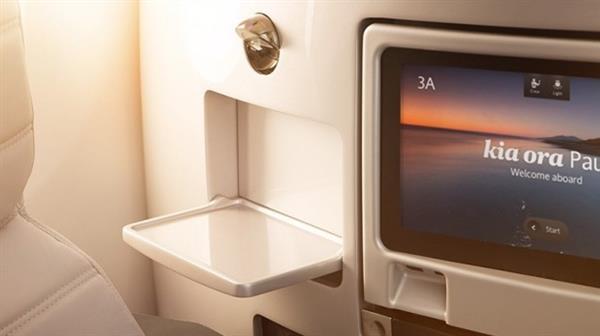Air New Zealand, the flag carrier airline of New Zealand, has partnered with Zenith Tecnica, an Auckland-based 3D titanium printing company, to manufacture 3D printed metal aircraft parts.
The metal parts will be printed with electron beam melting (EBM) printers manufactured by Arcam AB, a child company of GE Additive based in Sweden.
“Aircraft interiors are made up of tens of thousands of parts, and the ability to 3D print on demand lightweight parts we only require a small number of, rather than rely on traditional manufacturing methods is of huge benefit to our business, without compromising safety, strength or durability,” said Bruce Parton, COO of New Zealand Airline.
3D printed wine aerators and cocktail trays
In 2015, Zenith Tecnica acquired 3rd and 4th Arcam metal 3D printers. For the recent project, the company test printed novelty wine aerators and a metal frame for in-flight entertainment (IEF) screens, using an Arcam’s 3D EBM printer. The EBM technology melts and fuses metal powder or metal wire using an electron beam. Titanium alloys are one of the most common materials used in this method.
Since 2016, Air New Zealand has utilized 3D printing technology for part supplies and replacement. In collaboration with the Auckland University of Technology, the airline 3D printed fold down cocktail trays available to its Business Premier travelers.
The airline has also been working with Singapore Technologies Aerospace, an aerospace company specializing in MRO (maintenance, repair, operations), to explore advanced 3D printed airplane parts.

3D printed aircraft interiors
Using 3D printing technology commercial airlines have saved millions of dollars. In 2017, at the Global Manufacturing and Industrialization Summit, UAE’s Etihad Airways’ 3D printed airplane interior was displayed. The airline switched from traditional manufacturing of parts to on-demand 3D printing and saved significant costs by eliminating the need to store huge stocks of spare parts in a warehouse.
Nevertheless, 3D printing offers more than aircraft interior supplies. Last year, Airbus, in collaboration with the Chemnitz University of Technology, Germany, 3D printed a metal spoiler actuator for its A380 aircraft. The part is 35% lighter than manufactured by traditional milling process and has an improved design.
More design efficient and cost-effective solutions are in line for the aerospace industry. Autodesk designer Andreas Bastian came up with a novel method to 3D print airplane seats which are 56% lighter than traditional aluminum made seats. According to Bastian, this reduction in weight will save costs by minimizing fuel emission and in the long run will benefit the environment.
Catch all the exciting news relating to the aerospace industry by joining our 3D printing newsletter. Follow us on Facebook and Twitter.
If you are looking for a new career, take a look at our 3D printing job site.
Featured image shows the interior of Air New Zealand’s Boeing Boeing 787-9 Dreamliner. Photo via Air New Zealand


